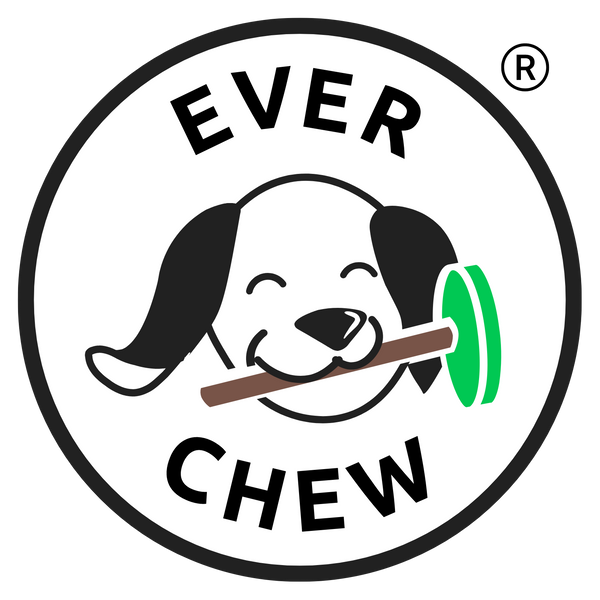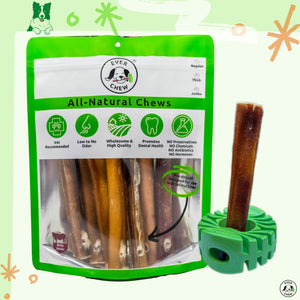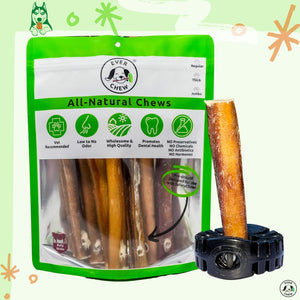Pit Bulls: A Guide to Chewing Bully Sticks

by Kirby Kendall (Inventor of EverChew)
Pit Bulls are compact, muscular dogs with distinctive broad heads and powerful jaw mechanics that reflect their historical breeding for strength and determination. These loyal, energetic dogs possess some of the strongest bite forces in the medium-sized dog category, making proper holder selection crucial for it to have a lifetime greater than a minute or two.
Powerful Bite Mechanics in a Compact Frame
American Pit Bulls and their mixes belong to the brachycephalic / mesocephalic family, meaning they have moderately shortened skulls with broad, muscular heads. This design creates significant mechanical advantages for bite force generation. Their thick temporalis muscles (the muscles that close the jaw) combined with their wide skull structure allow Pit Bulls to generate bite forces averaging over 230 PSI. The average human bite force is only 120-140 PSI.
Pit Bulls's dental alignment typically shows good spacing without the crowding issues common in flatter-faced breeds, but their "grip and hold" heritage means they tend to bite down and maintain pressure.
In Short—Which EverChew Holder?
Most adult Pit Bulls and Pit Bull mixes will require the indestructible black nylon SuperChew holder to withstand their powerful jaws and determined chewing style. Puppies, senior dogs, or exceptionally gentle individuals may start with the green Medium Plus holder, but most will need to graduate to the SuperChew for safety and durability.
Understanding Bully Stick Benefits and Why Holders Are Essential
Pit Bulls are natural, enthusiastic chewers, and this behavior serves multiple important purposes: dental health maintenance, mental stimulation, stress relief, and jaw muscle exercise. Bully sticks are pure protein treats (similar to beef jerky) that provide an ideal chewing texture—firm enough to satisfy their powerful jaws while acting like a natural toothbrush to scrape away plaque and tartar.
The bully stick stub can however become serious choking hazards or cause intestinal blockages requiring emergency surgery. Pit Bull's anatomy, including their broad throat structure, can may mean they could swallow a stub that will then become an intestinal blockage.
Behavioral Characteristics and Life Stages
Puppy Phase (8 weeks - 8 months): Pit Bull puppies display intense chewing behaviors that combine teething relief with their natural "grip and shake" instincts. Peak teething typically occurs between 3-6 months, during which they seek out firm textures to relieve discomfort from emerging adult teeth.
Adult Phase (8+ months): Most destructive chewing settles around 8-12 months, but Pit Bulls continue intense chewing throughout their lives. Many use chewing as a primary stress-relief mechanism, and under-stimulated Pit Bulls can quickly redirect their energy toward destructive chewing of furniture, doors, or other household items.
Selection Guidelines
Choose the EverChew Plus if your Pit Bull:
· Shows moderate or gentle chewing behavior
· Is a young puppy still developing bite strength
· Is a senior dog with potentially sensitive teeth
Choose the SuperChew if your Pit Bull:
· Demonstrates aggressive or power-chewing behavior
· Has destroyed other nylon toys or chew holders
· Shows the typical determined "grip and hold" chewing style
Avoid the Small Dog holder entirely—it's not designed to withstand Pit Bull jaw power.
.


